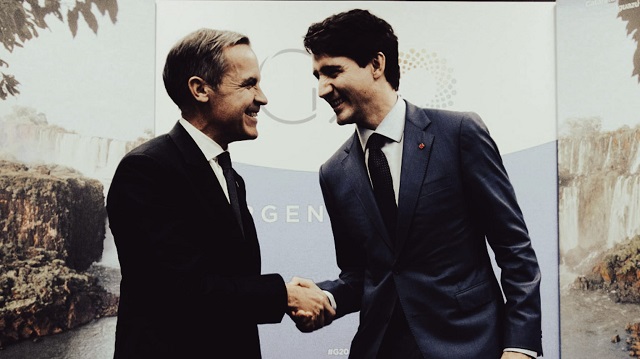Energy
How global warming saves more people than it dooms

From Energy Talking Points by Alex Epstein
This is Part 3 of a 4 part feature where I cover 4 of the top energy issues that will be discussed this summer, especially as politicians return home for August Recess.
Warmer temperatures are less of a threat than cold ones, and fossil fuels make us safer from both.
- Anti-fossil fuel politicians love summer because hot temperatures give them the opportunity to portray the world as “on fire”—and offering anti-fossil-fuel policies as a solution.In reality, cold is a bigger problem than heat—and anti-fossil-fuel policies make both worse.¹
- Anyone commentating responsibly on summer temperatures must acknowledge 3 facts:1. Heat-related deaths are far less prevalent than cold-related deaths
2. Earth is warming slowly—especially in warm places
3. Fossil fuels make us safer from both cold and heat
- 1. Heat-related deaths < cold-related deaths
When our leaders discuss the warming of the planet, they treat warming as obviously bad. But while they portray the planet as already “too hot,” the fact is that far more human beings die of cold than of heat.²
- Study after study has found that deaths from cold outnumber deaths from heat by 5-15 times. On every continent cold is more dangerous than heat. Even in many countries we think of as especially hot, such as India, cold-related deaths significantly exceed heat-related deaths.³
- 2. Earth is warming slowly—especially in warm places
So far we’ve had ~1°C of warming from a cold starting point in Earth’s history 150 years ago. Future warming will be limited by the diminishing nature of “the greenhouse effect”—as well as being concentrated in colder places.⁴
- Warming so far has been slow and benign. But will future warming make the world unlivably hot? No, given 2 facts almost universally acknowledged by climate scientists: 1) the diminishing warming impact of CO2 and 2) the concentration of warming in colder places.
- The warming impact of CO2 diminishes (“logarithmically”) as it increases in concentration.Every new molecule of CO2 we add to the atmosphere has less of a warming effect than the previous one. Warming will diminish as emissions increase—the only question is at what rate.⁵
- Climate warming is concentrated in colder areas of the world (such as the Arctic), during colder times of day, and during colder seasons.This means that future warming will occur more in cold situations where it saves lives than in hot situations where it causes problems.⁶
- All reporting on the warming of the Earth should specify not only that humans are far more endangered by cold than by heat, but also that Earth is warming slowly—and less in warm places. That virtually no reporting acknowledges this shows that much “reporting” is propaganda.
- 3. Fossil fuels make us safer from dangerous temperatures
Not only is the warming from fossil fuels’ CO2 emissions slow and in many ways beneficial, the uniquely cost-effective energy we get from fossil fuels makes us both safer from cold and heat.
- The key to being protected from dangerous temperatures is to master them by producing different forms of temperature protection, such as: insulated buildings, heating, and air-conditioning. All of these things require energy—which means for most people they require fossil fuels.
- Fossil fuels are the only source of low-cost, reliable energy that for the foreseeable future can provide energy to billions—in a world where 3 billion people still use less electricity than a typical American refrigerator.⁷
- On a planet where people die much more from cold than from heat, but both are major threats, the key to safety is to have energy be as affordable and plentiful as possible so as many as possible can afford heating and air conditioning. For now this means more fossil fuels.
- People who blaming pro-fossil-fuel politicians for hot temperatures evade that:1. Cold is more dangerous than heat
2. Warming is slow, especially in warm places
3. We need fossil fuels to protect us from cold and heat
- Reducing CO2 emissions in a humane and practical way means focusing on liberating alternatives—especially the most potent, nuclear—to try to truly outcompete fossil fuels in the future. Depriving us off fossil fuels now and pretending China will follow is immoral and impractical.
Popular links
- EnergyTalkingPoints.com: Hundreds of concise, powerful, well-referenced talking points on energy, environmental, and climate issues.
- My new book Fossil Future: Why Global Human Flourishing Requires More Oil, Coal, and Natural Gas—Not Less.
- Speaking and media inquiries
“Energy Talking Points by Alex Epstein” is my free Substack newsletter designed to give as many people as possible access to concise, powerful, well-referenced talking points on the latest energy, environmental, and climate issues from a pro-human, pro-energy perspective.
2025 Federal Election
Canada is squandering the greatest oil opportunity on Earth

Canada has 3X US oil reserves but less than 40% the production. Why? Anti-oil politicians like Mark Carney who say they’re protecting Earth’s coldest country from global warming.
- Canada has 170 billion barrels of proven oil reserves—by far the largest of any free country. And its producers can profit at $44 oil, vs. >$57 for US shale.
- Canadian oil production is also continuing to get cheaper. Oil sands operating costs have dropped 19% over the past five years, and the industry—which is still fine-tuning how to coax oil-like bitumen out of oil sands—has substantial room for further cost reductions.
- In addition to its massive proven oil reserves, Canada also has massive unexplored oil resources. Canada’s Northwest Territories may contain up to 37% of Canada’s total oil reserves, much of it light crude, which is even cheaper to extract and transport than bitumen from oil sands.
Canada is squandering this opportunity, with < 40% of US production and much slower growth
- Given Canada’s massive oil reserves and lower production costs, Canadian oil should have been growing far faster than US oil—on a path to producing even more oil than the US does.
Instead, Canada is totally squandering its oil opportunity, with less than 40% of US production and slower growth since 2010.
The lost opportunity is costing Canadians 100s of billions of dollars a year—and undermining global security
- In 2023, oil sands directly contributed C$38 billion to GDP—while total economic impact was 100s of billions of dollars. It could have been far, far greater.
- Canada’s oil underproduction is undermining both Canadian prosperity and global security. E.g., Europe’s dependence on Russian oil triggered an energy crisis after Russia invaded Ukraine. By doubling its oil production, Canada could make oil dictators weaker, the free world stronger—and Canada more powerful.
The cause: False climate ideas have led Canada to senselessly strangle its oil industry
Canada is squandering its oil opportunity by preventing its abundant oil from being transported to world markets
- With 3X US oil reserves but 1/8 the people, Canada can produce far more oil than it can use. So it needs a lot of transportation. Yet it wages war on pipelines, which are the cheapest, fastest, safest way to transport oil.
- In 2016, the Canadian government rejected the Northern Gateway pipeline from Alberta to B.C. after nearly a decade of review, citing insufficient Indigenous consultation. The pipeline would have carried 535K barrels of oil per day to Asia-Pacific markets, generating ~C$300B in GDP over 30 years.
- To make matters worse, several years after the cancellation of the Northern Gateway pipeline, Canadian Parliament passed Bill C-48 (the Oil Tanker Moratorium Act), banning large oil tankers from calling at northern B.C. ports and effectively shutting the door on any future pipeline to that region.
- In 2017, TC Energy canceled their Energy East pipeline project after the Canadian government demanded they calculate all of its indirect GHG emissions. The pipeline would have carried 1.1M barrels per day of Albertan and Saskatchewan oil to Eastern Canada, generating ~C$55B in GDP over 20 years.
- The Trans Mountain Expansion (TMX), operational in 2024, is Canada’s only new major pipeline in over a decade. Proposed in 2012, it barely survived years of political hurdles, progressing only after the federal government bought it in 2018. By completion, its costs had ballooned from the projected C$7.4B to C$34B.
- The main government-created obstacle for pipelines in Canada is the onerous federal “environmental review” process called the Impact Assessment Act (IAA), and before that, its precursor, the Canadian Environmental Assessment Act (CEAA).
- Under the Impact Assessment Act, the Canadian government can effectively veto a pipeline project by deeming it not in the “public interest,” as determined by factors including “sustainability,” alignment with climate goals, and impacts on Indigenous groups—but not economic benefits (!)
- Before the Impact Assessment Act was instituted in 2019, pipelines faced similarly onerous environmental reviews under its precursor, the Canadian Environmental Assessment Act (CEAA). Under CEAA, government could veto projects it judged to cause “significant adverse environmental effects,” a vague and open-ended criteria.
- Even if a pipeline project isn’t formally rejected by the Canadian government, the environmental review process can stretch on for years—often causing projects to collapse from escalating costs or investors withdrawing amid uncertainty. This is exactly what happened with the Energy East pipeline in 2017.
- If Canada built ample transportation, it would have the potential to produce even more oil than the US does and sell it around the world. Instead, its production is < 40% of the US’s, and 97% of its exports are to the US—at below-market prices.
Canada is also strangling oil investment, production, and refining
- Canada isn’t just strangling oil transport, it’s sabotaging oil at every stage—from Mark Carney’s proposed emissions cap to “Clean Fuel Regulations” to EV mandates to drilling bans to refinery restrictions.
- Investment in Canadian oil plunged over 50% (C$76B to C$35B) between 2014-2023—with investors pointing to regulatory uncertainty, inconsistencies, and compliance costs as major barriers to investments.
- A further looming threat to oil investment is the proposed cap on oil and gas sector GHG emissions. If implemented, as promised by Mark Carney’s government, this proposal will require the oil industry to reduce its GHG emissions to 35% of the 2019 level, which would significantly discourage investment and production.
- The Clean Fuel Regulations (CFRs), which mandate that Canadian fossil fuel producers reduce the emissions from fuels to 15% lower than 2016 levels by 2030, harms Canadian oil production by significantly increasing the cost of production and thus decreasing the domestic demand for gasoline and diesel.
- Canada’s EV mandate, which requires that 20% of vehicles sold in 2026, at least 60% of vehicles sold in 2030, and all new vehicles sold in 2035 are electric, harms Canadian oil production by greatly reducing the demand for gasoline and diesel.
- Canada’s consumer carbon tax, which until earlier this month imposed a fee of C$80 per ton of CO2, harmed Canadian oil production by raising gasoline prices by 17.6 cents per litre, thereby decreasing demand. Though this tax has been repealed, gasoline and diesel remain subject to the industrial carbon tax.
- In addition to measures that heavily disincentivize oil production, the federal government also directly limits production through moratoria on oil development on Canada’s Pacific and Arctic coasts, blocking access to hundreds of billions of barrels of oil.
- On top of Canada’s oil underinvestment and underproduction, Canadian oil refining has stagnated, with Canada’s refineries able to process less than half of the oil it produces and only one new refinery built since the 1980s.
The leading stranglers of Canadian oil, such as Trudeau and Carney, say they are protecting Canada and the world from a climate crisis
- The root cause of Canada’s squandered oil opportunity is leaders’ belief that world’s coldest country must stop global warming at all costs.
That’s why they advocate pursuing “net zero” by 2050—which necessarily means destroying Canada’s domestic oil industry.
- Canada has embraced climate catastrophism for over 3 decades now. For example, it was one of the original signatories of the UN Framework Convention on Climate Change (UNFCCC) in 1992. The UNFCCC has been the driving force behind “net zero” policies.
- Justin Trudeau took Canadian anti-oil policy to a new level, making the destruction of Canada’s oil opportunity a central focus: “We need to phase [oil sands] out,” he said in 2017, “We need to manage the transition off of our dependence on fossil fuels.”
- While Trudeau’s opposition to Canadian oil and therefore its economy is well-known, most Canadians do not know that Mark Carney is a far more committed opponent of Canadian oil than Justin Trudeau ever was. Indeed, Carney is one of the world’s leading “net zero” advocates.
- The last several decades of Mark Carney’s career have been focused on pressuring countries like Canada to adopt “net zero” policies that have proved ruinous. He did this as the head of the Bank of Canada and the Bank of England, and as the UN Special Envoy for Climate Action.
- Mark Carney’s past statements on climate include:
“investing for a net-zero world must go mainstream” (2019)
“those that fail to adapt [to net-zero] will cease to exist” (2019)
“build a financial system in which every decision takes climate change into account” (2021)
- Myth: Mark Carney used to be for carbon taxes but has changed his mind, as shown by his elimination of Canada’s carbon tax.
Truth: Carney is still for carbon taxes—because he is still for the net-zero agenda that requires taxing CO2 along with all other means to eliminate fossil fuels.
But while climate change is real, it is not a crisis—thanks to increasing resilience—nor is it addressed by unilateral Canadian sacrifice
- Far from facing a catastrophic climate crisis, Canada and the world are safer than ever from climate.
The global rate of climate disaster-related deaths has fallen 98% in the last 100 years—thanks to increasing climate resilience from reliable, affordable energy, including oil.
- Myth: Even if climate-related disaster deaths are down, climate-related damages are way up, pointing to a bankrupting climate future.
Truth: Even though there are many incentives for climate damages to go up—preferences for riskier areas, government bailouts—GDP-adjusted damages are flat.
- Sacrificing Canadian oil won’t make the coldest country in an increasingly climate-resilient world safer from global warming—since countries like China and India will never follow suit. What it will do is leave Canada far poorer, weaker, and more endangered from lack of energy.
The solution: Unleashing responsible oil development will make Canada rich, resilient, and secure
The rational path forward on climate is to embrace prosperity, which drives resilience and energy innovation
- Canada is safer than ever from climate, and other countries won’t cut emissions until it’s truly cost-effective to do so. The path forward is to embrace prosperity.
- The more prosperous Canada is, the more it can make itself more and more resilient to all manner of climate dangers. And the more prosperous Canada is, the more it can innovate new forms of energy that have the long-term prospect of outcompeting fossil fuels.
The number one path to Canadian prosperity is unleashing responsible development in the oil industry and other energy industries
- Canada must finally seize its enormous oil opportunity, unleashing investment, production, refining, and transport from irrational restrictions. Only then can Canada can deliver oil to eager markets worldwide.
- Canada should renounce its pledge to achieve “net zero by 2050” by repealing the Net-Zero Emissions Accountability Act where it is enshrined and withdrawing from the Paris Agreement. This will massively increase investor certainty about the future viability of the oil industry.
- Canada should reject the proposed GHG emissions cap for the oil industry. Canadian provinces that have their own carbon taxes and emission credit trading schemes should eliminate them too. This will improve investor expectations about the oil industry’s future viability.
- Canada should repeal the Impact Assessment Act (IAA) and replace it with a framework that minimizes the cost and duration of reviews and enshrines clear and narrow criteria for rejecting projects. This will help build more oil pipelines and reduce investor uncertainty about environmental regulations.
- Canada should revise the Canadian Energy Regulator Act (CERA) by limiting the certification review of the covered oil pipeline projects to the question of whether there is sufficient proven demand for the oil they are planning to transport. This will expedite pipeline approval.
- Canada should repeal the Oil Tanker Moratorium Act (Bill C-48), which bans large oil tankers off the northern and central coast of British Columbia. This will open the door to building pipelines to B.C. that can transfer oil to crucial Asian markets.
- Canada should repeal the Clean Fuel Regulations (CFR) and the EV mandate. This will boost investor confidence in oil by increasing both current and anticipated domestic demand for oil-derived fuels.
- Canada should repeal the federal moratoria on offshore oil drilling on the Pacific Coast and in the Canadian Arctic. This will unlock up to hundreds of billions of barrels of Canadian oil.
- To stop squandering the world’s greatest energy opportunity, Canada must start electing leaders who value Canadian energy, and stop electing leaders with a proven track record of destroying it.
Daniil Gorbatenko, Steffen Henne, and Michelle Hung contributed to this piece.
“Energy Talking Points by Alex Epstein” is my free Substack newsletter designed to give as many people as possible access to concise, powerful, well-referenced talking points on the latest energy, environmental, and climate issues from a pro-human, pro-energy perspective.
Alberta
Low oil prices could have big consequences for Alberta’s finances

From the Fraser Institute
By Tegan Hill
Amid the tariff war, the price of West Texas Intermediate oil—a common benchmark—recently dropped below US$60 per barrel. Given every $1 drop in oil prices is an estimated $750 million hit to provincial revenues, if oil prices remain low for long, there could be big implications for Alberta’s budget.
The Smith government already projects a $5.2 billion budget deficit in 2025/26 with continued deficits over the following two years. This year’s deficit is based on oil prices averaging US$68.00 per barrel. While the budget does include a $4 billion “contingency” for unforeseen events, given the economic and fiscal impact of Trump’s tariffs, it could quickly be eaten up.
Budget deficits come with costs for Albertans, who will already pay a projected $600 each in provincial government debt interest in 2025/26. That’s money that could have gone towards health care and education, or even tax relief.
Unfortunately, this is all part of the resource revenue rollercoaster that’s are all too familiar to Albertans.
Resource revenue (including oil and gas royalties) is inherently volatile. In the last 10 years alone, it has been as high as $25.2 billion in 2022/23 and as low as $2.8 billion in 2015/16. The provincial government typically enjoys budget surpluses—and increases government spending—when oil prices and resource revenue is relatively high, but is thrown into deficits when resource revenues inevitably fall.
Fortunately, the Smith government can mitigate this volatility.
The key is limiting the level of resource revenue included in the budget to a set stable amount. Any resource revenue above that stable amount is automatically saved in a rainy-day fund to be withdrawn to maintain that stable amount in the budget during years of relatively low resource revenue. The logic is simple: save during the good times so you can weather the storm during bad times.
Indeed, if the Smith government had created a rainy-day account in 2023, for example, it could have already built up a sizeable fund to help stabilize the budget when resource revenue declines. While the Smith government has deposited some money in the Heritage Fund in recent years, it has not created a dedicated rainy-day account or introduced a similar mechanism to help stabilize provincial finances.
Limiting the amount of resource revenue in the budget, particularly during times of relatively high resource revenue, also tempers demand for higher spending, which is only fiscally sustainable with permanently high resource revenues. In other words, if the government creates a rainy-day account, spending would become more closely align with stable ongoing levels of revenue.
And it’s not too late. To end the boom-bust cycle and finally help stabilize provincial finances, the Smith government should create a rainy-day account.
-

 2025 Federal Election16 hours ago
2025 Federal Election16 hours agoNine Dead After SUV Plows Into Vancouver Festival Crowd, Raising Election-Eve Concerns Over Public Safety
-

 2025 Federal Election14 hours ago
2025 Federal Election14 hours agoMark Carney: Our Number-One Alberta Separatist
-

 Opinion1 day ago
Opinion1 day agoCanadians Must Turn Out in Historic Numbers—Following Taiwan’s Example to Defeat PRC Election Interference
-

 International2 days ago
International2 days agoHistory in the making? Trump, Zelensky hold meeting about Ukraine war in Vatican ahead of Francis’ funeral
-

 C2C Journal1 day ago
C2C Journal1 day ago“Freedom of Expression Should Win Every Time”: In Conversation with Freedom Convoy Trial Lawyer Lawrence Greenspon
-

 International17 hours ago
International17 hours agoJeffrey Epstein accuser Virginia Giuffre reportedly dies by suicide
-

 2025 Federal Election17 hours ago
2025 Federal Election17 hours agoColumnist warns Carney Liberals will consider a home equity tax on primary residences
-

 2025 Federal Election2 days ago
2025 Federal Election2 days agoCarney’s budget is worse than Trudeau’s













